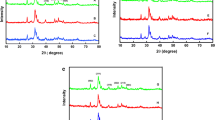Abstract
In this study, hydroxyapatite (HAp) particles with mesoporous structure have been synthesized from calcium hydroxide and di-ammonium hydrogen phosphate using yeast cells as the template. The characterization methods such as X-ray diffraction (XRD), Fourier transform infrared spectrograph (FTIR), N2 adsorption–desorption isotherms (NADI), transmission electron microscopy (TEM) and field emission scanning electron microscopy (FESEM) were used for determination of the particles structure (particle size, structural evolution and morphology). The results show that HAp particles with mesoporous structure could be produced. The size of HAp particles was approximately hundreds of nanometer. The pore width of HAp particles was in the range of 2.0–40 nm and the maximum centered around 4.5 nm.






Similar content being viewed by others
References
Temenoff JS, Mikos AG. Review: tissue engineering for regeneration of articular cartilage. Biomaterials. 2000;21:431–40.
Burg KJL, Porter S, Kellam JF. Biomaterial developments for bone tissue engineering. Biomaterials. 2000;21:2347–59.
Wang HN, Li YB, Zuo Y, Li JH, Ma SS, Cheng L. Biocompatibility and osteogenesis of biomimetic nano-hydroxyapatite/polyamide composite scaffolds for bone tissue engineering. Biomaterials. 2007;28:3338–48. doi:10.1016/j.biomaterials.2007.04.014.
Kokubo T, Kim HM, Kawashita M. Novel bioactive materials with different mechanical properties. Biomaterials. 2003;24:2161–75. doi:10.1016/S0142-9612(03)00044-9.
Dash AK, Cudworth GC. Therapeutic applications of implantable drug delivery systems. J Pharmacol Toxicol Methods. 1998;40:1–12.
Cheng WP, Gray AI, Tetley L, Hang TLB, Schätzlein AG, Uchegbu IF. Polyelectrolyte nanoparticles with high drug loading enhance the oral uptake of hydrophobic compounds. Biomacromolecules. 2006;7:1509–20. doi:10.1021/bm060130l.
Bezzi G, Celotti G, Landi E, La Torretta TMG, Sopyan I, Tampieri A. A novel sol–gel technique for hydroxyapatite preparation. Mater Chem Phys. 2003;78:816–24.
Andersson J, Areva S, Spliethoff B, Lindén M. Sol–gel synthesis of a multifunctional, hierarchically porous silica/apatite composite. Biomaterials. 2005;26:6827–35. doi:10.1016/j.biomaterials.2005.05.002.
Kumar R, Prakash KH, Cheang P, Khor KA. Temperature driven morphological changes of chemically precipitated hydroxyapatite nanoparticles. Langmuir. 2004;20:5196–200. doi:10.1021/la049304f.
Mobasherpour I, Soulati Heshajin M, Kazemzadeh A, Zakeri M. Synthesis of nanocrystalline hydroxyapatite by using precipitation method. J Alloys Compd. 2007;430:330–3. doi:10.1016/j.jallcom.2006.05.018.
Wang YJ, Zhang SH, Wei K, Zhao NR, Chen JD, Wang XD. Hydrothermal synthesis of hydroxyapatite nanopowders using cationic surfactant as a template. Mater Lett. 2006;60:1484–7. doi:10.1016/j.matlet.2005.11.053.
Bose S, Saha SK. Synthesis and characterization of hydroxyapatite nanopowders by emulsion technique. Chem Mater. 2003;15:4464–9. doi:10.1021/cm0303437.
Itatani K, Iwafune K, Scott Howell F, Aizawa M. Preparation of various calcium-phosphate powders by ultrasonic spray freeze-drying technique. Mater Res Bull. 2000;35:575–85.
Zarur AJ, Hwu HH, Ying JY. Reverse microemulsion-mediated synthesis and structural evolution of barium hexaaluminate nanoparticles. Langmuir. 2000;16:3042–9. doi:10.1021/la9908034.
Althues H, Kaskel S. Sulfated Zirconia nanoparticles synthesized in reverse microemulsions: preparation and catalytic properties. Langmuir. 2002;18:7428–35. doi:10.1021/la0202327.
Banat IM, Makkar RS, Cameotra SS. Potential commercial applications of microbial surfactants. Appl Microbiol Biotechnol. 2000;53:495–508.
Kitamoto D, Isoda H, Nakahara T. Functions and potential applications of glycolipid biosurfactants from energy-saving materials to gene delivery carriers. J Biosci Bioeng. 2002;94:187–201.
Breierova E, Vajczikova I, Sasinkova V, Stratilova E, Fišera M, Gregor T, Šajbidor J. Biosorption of cadmium ions by different yeast species. Z Naturforsch C. 2002;57:634–9.
Burattini E, Cavagna M, Dell’Anna R, Malvezzi Campeggi F, Monti F, Rossi F, et al. A FTIR microspectroscopy study of autolysis in cells of the wine yeast Saccharomyces cerevisiae. Vib Spectrosc. 2008;47:139–47.
Joris SJ, Amberg CH. The nature of deficiency in nonstoichiometric hydroxyapatites. II. Spectroscopic studies of calcium and strontium hydroxyapatites. J Phys Chem. 1971;75:3172–8.
Blakeslee KC, Condrate RA. Vibration spectra of hydrothermal prepared hydroxyapatites. J Am Ceram Soc. 1971;54:559–63.
Cheng ZH, Yasukawa A, Kandori K, Ishikawa T. FTIR Study on incorporation of into calcium hydroxyapatite CO2. J Chem Soc Faraday Trans. 1998;94:1501–5.
Acknowledgments
This research was supported by the National Key Basic Research 973 Program of China (Grant 2005CB623902), National Natural Science Foundation of China (Grant 50572029) and Natural Science Foundation Team Project of Guangdong (Grant 04205786).
Author information
Authors and Affiliations
Corresponding authors
Rights and permissions
About this article
Cite this article
He, W., Li, Z., Wang, Y. et al. Synthesis of mesoporous structured hydroxyapatite particles using yeast cells as the template. J Mater Sci: Mater Med 21, 155–159 (2010). https://doi.org/10.1007/s10856-009-3865-3
Received:
Accepted:
Published:
Issue Date:
DOI: https://doi.org/10.1007/s10856-009-3865-3




